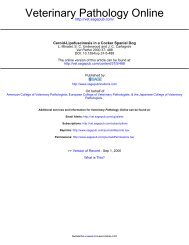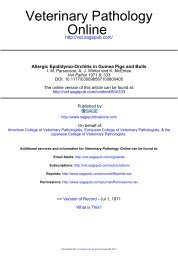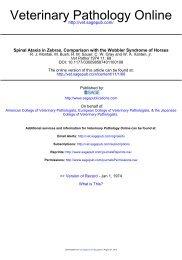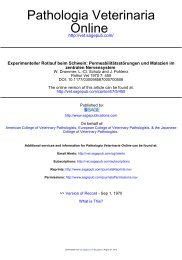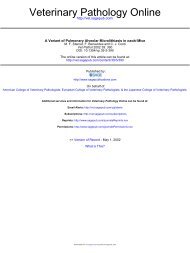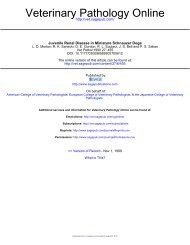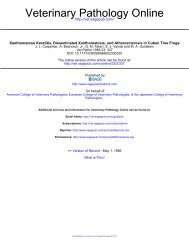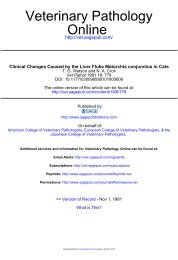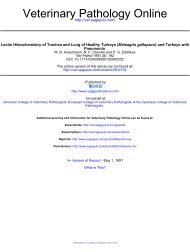Mammary Gland Neoplasia in the Cow - Veterinary Pathology
Mammary Gland Neoplasia in the Cow - Veterinary Pathology
Mammary Gland Neoplasia in the Cow - Veterinary Pathology
You also want an ePaper? Increase the reach of your titles
YUMPU automatically turns print PDFs into web optimized ePapers that Google loves.
<strong>Mammary</strong> <strong>Gland</strong> <strong>Neoplasia</strong> <strong>in</strong> <strong>the</strong> <strong>Cow</strong> 509<br />
is only HOFMEYR’S report?’ of a ‘sp<strong>in</strong>dle-cell sarcoma’ <strong>in</strong> a Jersey cow which <strong>in</strong>volved<br />
much of <strong>the</strong> left side of <strong>the</strong> udder, was some 22 cm <strong>in</strong> diameter, and had a<br />
necrotic centre. This tumour HOFMEYR successfully removed by complete mastectomy.<br />
A noteworthy feature of this present fibrosarcoma was <strong>the</strong> extremely high<br />
<strong>in</strong>cidence of mult<strong>in</strong>ucleate giant cells. € 3 0 classifies ~ ~ ~ giant cells <strong>in</strong>to 3 types:<br />
tumour giant cells ; foreign-body giant cells, characterised by be<strong>in</strong>g phagocytic; and<br />
a miscellaneous group <strong>in</strong>clud<strong>in</strong>g <strong>the</strong> Reed-Sternberg cell of Hodgk<strong>in</strong>’s disease <strong>in</strong><br />
man. In foreign-body mult<strong>in</strong>ucleate cells, <strong>the</strong> nuclei tend to form a peripheral<br />
palisade, whereas <strong>in</strong> <strong>the</strong> tumour giant cell, as <strong>in</strong> <strong>the</strong> above case, <strong>the</strong> nuclei are<br />
ei<strong>the</strong>r diffuse with<strong>in</strong> <strong>the</strong> cytoplasm or tend to aggregate centrally. Giant cells can<br />
occur <strong>in</strong> virtually any type of tumour, but EvA~sl~, <strong>in</strong> <strong>the</strong> case of human fibrosarcomata<br />
at least, states that although mult<strong>in</strong>ucleated cells may be found <strong>the</strong>y<br />
are not a spectacular feature, and <strong>in</strong>deed Srou~38 considers <strong>the</strong>m exceed<strong>in</strong>gly uncommon.<br />
WILL IS^^ on <strong>the</strong> o<strong>the</strong>r hand writes that <strong>the</strong> more undifferentiated fibrosarcomata<br />
often <strong>in</strong>clude many giant and mult<strong>in</strong>ucleated tumour cells.<br />
We have reviewed 50 tumours diagnosed as fibrosarcoma at this school over<br />
<strong>the</strong> past 10 years, and <strong>in</strong> only 2-1 dog (a metastatic fibrosarcoma <strong>in</strong> <strong>the</strong> liver), and<br />
1 horse (a sub-cutaneous neoplasm) were giant cells easily found. Giant cells were<br />
not mentioned <strong>in</strong> <strong>the</strong> mammary sarcoma reported by HOFMEYR~~.<br />
A neoplasm where mult<strong>in</strong>ucleated giant cells are a spectacular feature is <strong>the</strong><br />
osteoclastoma or giant-cell tumour of bone. In gross and macroscopic appearance<br />
JAFFE’SZ3 account of this tumour <strong>in</strong>dicates a fairly close similarity to <strong>the</strong> tumour<br />
presently described. NIELSEN~~ described a giant-cell tumour of <strong>the</strong> fore-leg<br />
<strong>in</strong> a cat. This tumour was extraskeletal and was presumed to have orig<strong>in</strong>ated <strong>in</strong> <strong>the</strong><br />
tendons or tendon sheaths. The type of giant cell and <strong>the</strong>ir distribution <strong>in</strong> a stroma<br />
which appeared to be of atypical fibroblasts arranged <strong>in</strong> a sarcomatous pattern,<br />
with evidence that <strong>the</strong>se fibroblasts were <strong>in</strong> fact <strong>the</strong> precursors of <strong>the</strong> giant cells,<br />
is a picture bear<strong>in</strong>g strik<strong>in</strong>g resemblance to <strong>the</strong> case here described. NIELSEN~I<br />
also observed that some giant cells had a darker cytoplasm and smaller hyperchromatic<br />
nuclei. This we also saw (Fig. 3). It is debatable whe<strong>the</strong>r <strong>the</strong>se were<br />
merely older, pyknotic, forms of tumour giant cells or phagocytic foreign body<br />
giant cells of reticuloendo<strong>the</strong>lial orig<strong>in</strong>. The possible phagocytic property of many<br />
of <strong>the</strong> giant cells <strong>in</strong> our case as <strong>in</strong>dicated by vacuolation with, <strong>in</strong> some cases, vacuoles<br />
conta<strong>in</strong><strong>in</strong>g sta<strong>in</strong>able material is paralleled by <strong>the</strong> condition of man described<br />
by JAFFE~~ as nodular tenosynovitis. In this lesion, which JAFFE considers to represent<br />
an <strong>in</strong>flammatory reaction ra<strong>the</strong>r than a true neoplastic change, mult<strong>in</strong>ucleate<br />
giant cells able to phagocytose haemosider<strong>in</strong> and lipid are a feature. These<br />
lesions apparently commonly arise from tendon sheaths and/or <strong>the</strong> fascia1 and<br />
ligamentous tissues adjacent to <strong>the</strong>m. A similar condition has been described <strong>in</strong> <strong>the</strong><br />
horse129 34. PLUMMER~~ <strong>in</strong> his review of tumours classified 2 bov<strong>in</strong>e specimens as<br />
‘giant-cell sarcomas’. One <strong>in</strong>volved rib, pleura, lung, and bronchial lymph nodes.<br />
No <strong>in</strong>formation was available on <strong>the</strong> location of <strong>the</strong> o<strong>the</strong>r.<br />
Mult<strong>in</strong>ucleate giant cells have been seen <strong>in</strong> those sarcomas of <strong>the</strong> mammary<br />
gland <strong>in</strong> <strong>the</strong> bitch which appear to be related to osteosarcomas, and may be of<br />
myoepi<strong>the</strong>lial orig<strong>in</strong>lo. No bone or cartilage element was found <strong>in</strong> this reported<br />
case and <strong>the</strong>re was no histochemical evidence for <strong>the</strong> presence of myoepi<strong>the</strong>lial<br />
cells <strong>in</strong> <strong>the</strong> tumourous tissue.<br />
Downloaded from vet.sagepub.com by guest on January 21, 2014



